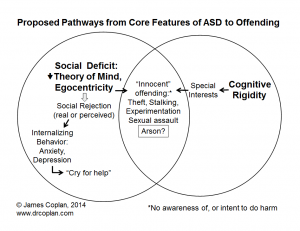Internalizing
July 1st, 2014 by drcoplan Click on figure to view full size.
Dr. Coplan maps the connections between social rejection, internalizing behavior, and suicide risk in persons with autism spectrum disorder. Internalizing behavior usually does not trigger criminal offending, but it can be the prequel to violent externalizing behavior.
The British psychiatrist Lorna Wing passed away last month, after a long career dedicated to bettering the lives of persons with ASD, including her own daughter. It was Lorna Wing who in 1981 coined the term “Asperger Syndrome.” This blog post is dedicated to her memory and legacy.
Here is the list of factors Dr. Wing enumerated as contributors to crime committed by persons on the spectrum (I have re-ordered the items):
1. Assumption that the person’s own needs supersede all other considerations
2. Lack of awareness of wrongdoing
3. Intellectual interest (what Asperger himself called “Autistic acts of malice”)
4. Pursuit of “special” interests (objects, people)
5. Vulnerability
6. Cry for help
7. Hostility towards family
8. Hyperarousal
9. Revenge
In our last post on the subject of ASD and crime, I introduced the term “innocent offending” to describe criminal behavior stemming from the combination of obsessive interests and lack of social awareness (Items 1-4 in Wing’s list). Here, I’ve added another pathway to the diagram, this time leading from social rejection to internalizing behavior.
Click on figure to view full size.















